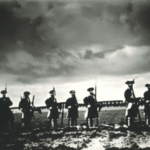The Iroquois Confederacy: A Powerful Native American Alliance
The Iroquois Confederacy, also known as the Haudenosaunee, was a powerful Native American alliance that played a significant role in the history of North America. Formed around the late 16th century, the Confederacy consisted of six tribes: the Mohawk, Oneida, Onondaga, Cayuga, Seneca, and Tuscarora. Together, they created a unique political and social structure that lasted for centuries.
Origins and Formation
The origins of the Iroquois Confederacy can be traced back to the efforts of a legendary figure named Hiawatha and a Mohawk chief named Deganawidah. According to tradition, Hiawatha, who had experienced personal tragedy, sought to bring peace and unity among the warring tribes of the region. With the help of Deganawidah, they developed the Great Law of Peace, a constitution that established the framework for the Confederacy.
The Great Law of Peace
The Great Law of Peace was a visionary document that provided a system of governance for the Iroquois Confederacy. It emphasized the principles of democracy, equality, and consensus decision-making. The Confederacy was organized into clans, and each tribe had representatives in a central council known as the Grand Council. This council was responsible for making decisions on matters of common interest, such as warfare, trade, and diplomacy.
Political Structure and Leadership
The Iroquois Confederacy had a complex political structure that balanced power between the tribes. The Onondaga tribe held a central position and served as the “firekeepers” of the Confederacy. The Mohawk and Seneca tribes were known as the “elder brothers,” while the Oneida and Cayuga tribes were the “younger brothers.” The Tuscarora tribe joined the Confederacy in the early 18th century.
Relations with European Colonizers
The Iroquois Confederacy had a significant impact on the European colonization of North America. The Confederacy maintained a policy of neutrality and skillfully played European powers against each other to maintain their independence. They formed alliances with both the French and the British, depending on their strategic interests. However, as European colonization expanded, conflicts with the Iroquois intensified, leading to a series of wars known as the Beaver Wars.
Legacy and Influence
The Iroquois Confederacy left a lasting legacy on the history and culture of North America. Their political structure and principles of governance influenced the founding fathers of the United States, who admired their democratic ideals. The Confederacy’s system of consensus decision-making and the concept of a federation of states were incorporated into the United States Constitution. Additionally, the Iroquois Confederacy’s oral tradition and cultural practices continue to be preserved and celebrated by Native American communities today.
Challenges and Revival
In the 19th century, the Iroquois Confederacy faced numerous challenges due to the encroachment of European settlers and the policies of the United States government. The Confederacy’s lands were gradually diminished, and their traditional way of life was disrupted. However, in the 20th century, there was a revival of Iroquois culture and political activism. The Iroquois Confederacy played a crucial role in the Native American rights movement and the fight for self-determination.
Conclusion
The Iroquois Confederacy stands as a testament to the power of unity and diplomacy. Their political structure, democratic principles, and influence on the formation of the United States make them a significant force in North American history. Despite the challenges they faced, the Iroquois Confederacy’s legacy continues to inspire and shape the lives of Native American communities today.












